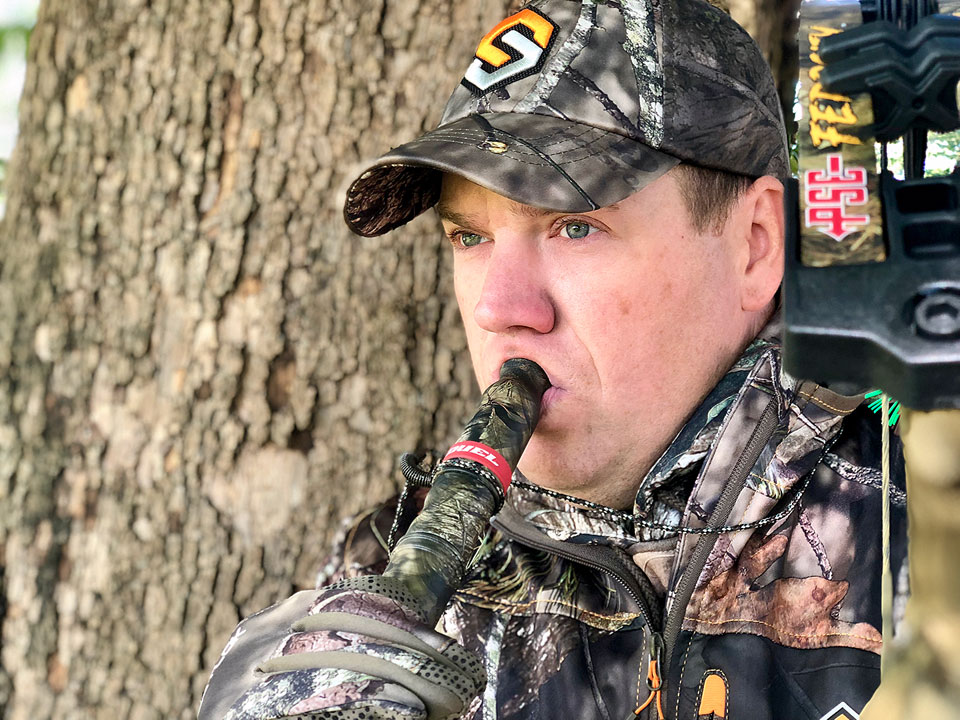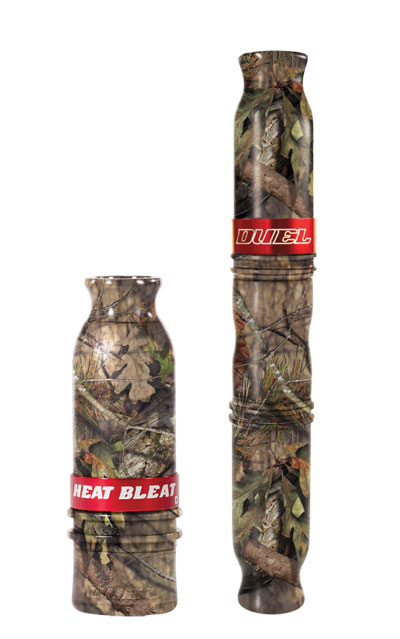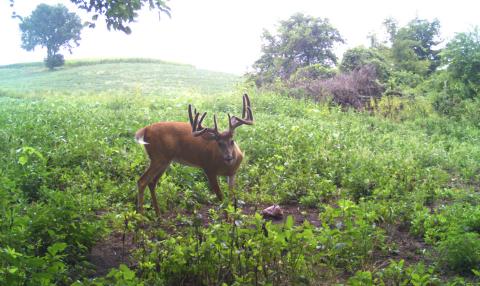Heath Wood

As a teenager in the late 90s, my obsession with the hunting world was beginning to take flight. My time was consumed with thinking about it, reading about, and watching hours upon hours of hunting videos. I can recall a couple of different “how to” videos that really grabbed my attention. The first one being a video that came with a grunt call from the legendary Knight and Hale Game Calls. In this video, Harold Knight and David Hale explained different deer sounds, when to use them, and of course how to use a call to bring deer in. The other video was also one that came with a call; it was a video from Hunter’s Specialties featuring Greg Miller and a deer calling champion named Phil Liddle, who I would later meet and discuss calling with. This video was the first one in which I can recall someone talking about realism when it comes to deer calling. The one word from that video that has continued to stick with me throughout the years is “inflection,” which is defined as the modulation of intonation or pitch in the voice. As Miller and Liddle explained, using inflection creates realism in deer calling due to the tone not being the same all of the time, instead adding high and low tones while calling helps fool a deer into thinking it is the real thing.
These videos where produced nearly 20 years ago. It seems that in today's world we don’t see or hear much of the how tos when it comes to using deer scents, lures or grunt calls. Yes, several companies continue to develop new products each year, however, it is more about the science and technology used instead of using the old school products such as a grunt call. This is most likely due to the fact that hunters got tired of seeing this so often in the 90s and early 2000s, not because it isn’t important anymore. In my opinion, it is something that needs to continue to be a topic of discussion, just as the video that I watched over two decades ago. Adding realism when deer calling is something that still needs to be taught.
As an avid game caller, I take pride in using calls to bring wildlife into close range. Whether it is practicing howling on a diaphragm coyote howler or purring on a diaphragm turkey call, it takes hours of practice to create the realism in calling that is needed to be successful. However, something that one will not come across is a lot of literature on practicing a grunt call. Many hunters think that when it comes to calling deer a grunt is a grunt and practice isn’t needed to sound good. A hunter should know and understand the vocabulary of deer, when to call and how to sound like a real deer. By having an understanding of the different sounds a deer can make, a hunter’s level of calling will increase, and they will become noticeably more successful.
There are a few sounds that a deer produces that hunters should learn to duplicate, as well as know what those sounds mean when making them.
Social Calling
This can consist of doe and buck sounds that I refer to as the yelp of deer calling. The yelp is the most often used turkey call due to its ease of duplicating the sound with a call, as well as its effectiveness in bringing the animal into range. The same goes for using social grunts or doe bleating.
The most common sound for a buck is the social grunt. This is a call that bucks will make by grunting. It is nothing loud or exciting, instead it is a sound that is used to communicate with other deer. This sound is not intended for any breeding purpose, more so just a nonchalant communication call to let other deer know his location and presence. This is one of my favorite calls to make all year long. Performing this sound while hunting creates curiosity from other deer, as well as provides a sense of comfort by letting other deer in the area know that they have company.
As for the doe, the bleat is the preferred social call. It, too, is used as a communication call to other deer, especially fawns. This is a sound that a doe will make so that the fawns always know her location. This call can also be made to relax other deer in the area. The social calls are sounds that hunters can make periodically while hunting, and when done right, they will sound like a real deer.
Blowing a call two or three times without any thought is not good calling. Listen to various YouTube videos and recordings of actual deer sounds. Mimic those sounds by using little air to produce the sound, I also occasionally close my eyes when calling to visualize an actual deer making the sounds. This helps create realism, which makes calling more successful.
Calling During The Rut

This is the majority of hunters’ favorite calls to make when hunting, mostly because it is done during the rut which in itself is an exciting time to be in the woods. Add a buck responding to calls to the mix and the excitement level rises even more. A trailing grunt, for instance, is a quick burst of grunts made by a buck when trailing the scent of a doe during the rut. This call is most often performed during the pre-rut when bucks are out cruising the woods in search of an estrus doe. When the buck finally finds the scent, he will then follow that trail similar to that of a dog following a scent trail. His nose will be to the ground, leading the way with nothing else on his mind except finding that doe to breed. While doing this, a buck will make short grunts with almost every step he takes, which is why it is called a trailing grunt. Hunters can reproduce this sound on a call to make other bucks in the area think that another buck has invaded his area and is in pursuit of a hot doe. This, too, is a scenario in which realism is key. When producing this sound, I will picture a buck walking through the woods, grunting with each step, and I incorporate inflection into my calling by getting louder than lower in similarity of a buck trailing a hot doe.
The next grunt to master is the tending grunt. This is the sound a buck will make when he has finally found a doe that is ready to breed. In my opinion, this call is the most important when it comes to realism. This sound is a deep sound that begins with a low guttural sound then is followed by a louder deep grunt sound. This sound can mean a couple of different things. It can be made as a sign of dominance to other bucks as well as to show off to the doe he is getting ready to tend. It can also be made if the doe is ready to breed but is playing hard to get by not letting the buck breed her. When the doe is playing hard to get, this sound will be made in anger. This is where using inflection in the grunt call can help add realism in calling. By making a realistic sounding tending grunt, other bucks in the area think another buck is attempting to breed a doe. Thus causing dominant bucks in the area to come in to chase off the buck and tend to the doe himself.
Learn to Call Deer
Since the meaning of different deer vocalizations has been explained, it is time to learn to make these sounds. All you need is a quality grunt call that produces the most realistic sounds and practice. A grunt call choice that I have found to be realistic is the The Rut Pack 3 from Duel Game Calls. This kit includes the Double Back Grunt Call which features an adjustable soundboard with seven different positions to create sounds ranging from a fawn to a mature buck. This call is used by exhaling on one end for louder sounds that are intended to carry a long distance and inhaling on the other side to create realistic, subtle quiet calls that are made due to the dual resonating chamber that helps make the most authentic deer sounds. The second call of this two-pack kit is the Micro Heat Bleat Call. This call is smaller in size and sound but produces realistic doe grunts, bleats and even estrus bleats. Both calls are also covered in Mossy Oak Break-Up Country.
In the world of competitive turkey calling, there has been a noticeable change that has taken place over the last 10 years, that being the high level of competition. The sounds that are produced on stage nowadays are so realistic and authentic that it is almost breathtaking to listen to. This was all done using quality calls that are available on the market, as well as an understanding of realism by the callers of the sounds, and hours of practice. This same level of calling can be achieved on a deer call as well.
There are several deer calls on the market today that sound more realistic than any previous deer calls that have been produced. An understanding of what sounds deer make, when they make them and why they make them, followed by a hunter’s ability to produce authentic sounds from a call, will in turn bring a high level of success in deer calling with each hunt.



















